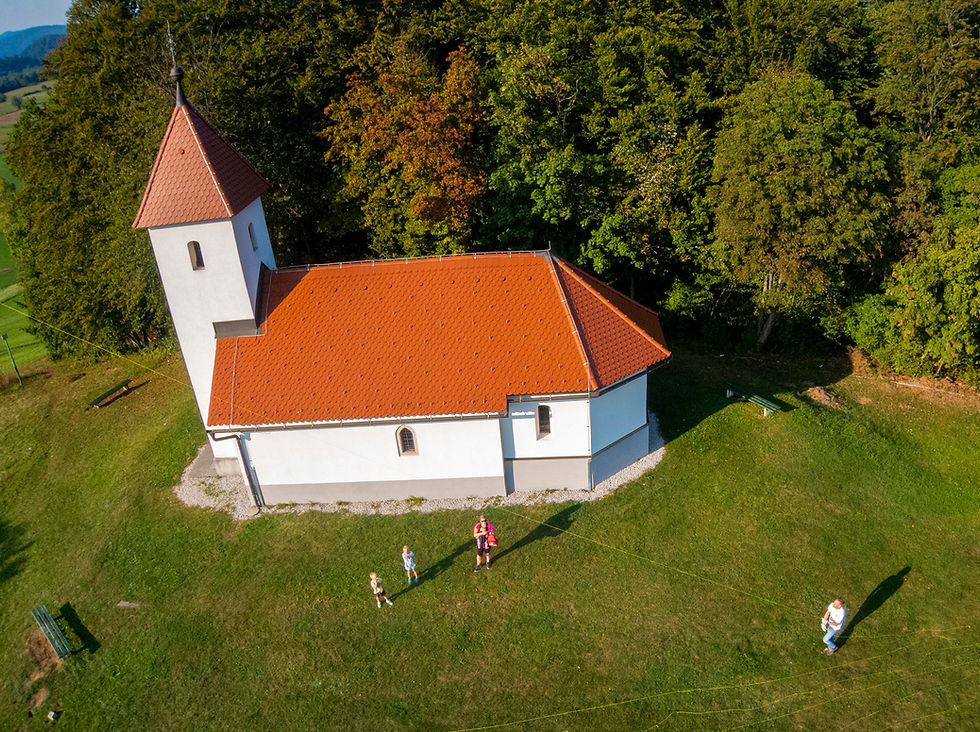Saint Lawrence of Thousands of Years
- kapjasa
- Sep 16, 2020
- 3 min read
Updated: Sep 17, 2020
The legend of Laurentius, one of the seven deacons of Rome, is quite amusing (for a martyrdom story) - when he was tortured on a gridiron over the fire, he called out: "Turn me over, I'm well done on this side!" ... Thus he is a patron saint of cooks and comedians.
Saint Lawrence is one of the most widely venerated saints of the Catholic Church, and there are numerous churches and chapels dedicated to him. This one is a pretty incospicuouos one, perched on top of a small hillock at the southern end of Ljubljana Marshes, near the village of Jezero:

However, this church of St. Lawrence and the hill on which it was built are quite exceptional!

St. Lawrence on a hill with sprawling Ljubljana Marshes below
The little church was built in the 11th or 12th century in Romanesque style. The humble structure is oriented in an old-school strict east-west direction, with the sanctuary and the altar at the eastern end, and a small belltower at the western end. The current nave is from the 15th century, decorated with simple frescoes that were recently renovated.

15th century frescoes on the northern wall
But the history of this hill didn't start in the 11th century ... it goes waaaaaaay back :-)

This is a LIDAR image of the St. Lawrence hill ... the extensive terracing is a big clue that human history here started a long long time ago. An archaeological survey unearthed some pretty amazing facts about this site.
A Mesolithic hunting station and lithic industry site was found on the hill - 15.000 years ago a small tribe of hunter-gatherers came here and enjoyed the strategic value of the higher ground; the hill provided some basic safety, the forests above and the swampy lake below were abundant sources of food.

Spot the blue Rokkaku kite!
Later a Neolithic settlement was established on the hill, evolving through the Bronze and Iron age - at that time they most probably did the prominent terracing - and finally into a Roman outpost guarding the vicinal roads of the southern end of the Marshes.

Ancient terraces are clearly visible from a kite
The tumult after the collapse of the Roman Empire left the countryside in tatters, the Völkerwanderung period was dark, and the early Slavs - who surely settled here - didn't make any permanent structure ...

So the history that started 15.000 years ago (just after the end of the Ice Age!) and was developing nicely up to the 4th century AD, had a slight pause - until the Medieval people built a little shrine to Saint Lawrence at the top of the terraced hill ...

As the centuries went, bigger, better, and more modern churches were built all around, and the little St. Lawrence couldn't keep up ... only the villagers of Jezero were celebrating mass in their church, and only when the priest from another parish had the time to come here.

Incidentally, the village of Jezero - meaning 'Lake' - got its name from a small and nearly circular lake just beside the village. The lake is a flooded karstic abyss and with over 50 m of depth is among the deepest lakes in Slovenia! Luckily one of our Rokkakus was feeling frisky and did some loops, and the camera momentarily pointed in the right direction:

Jezero village and its circular lake
Today not many people visit St. Lawrence, even though it is such a cute place. But those who do can feel the history that shaped the hill and its little church ...
Prompted by the sound of a small bell tolling, the mind wanders back to when the frescoes were painted, the little shrine constructed; and further on passing the Roman legions, meeting the Bronze Age farmers, seeing the Marshes fill up with water, observing Neolithic masters of stone knapping some flint, and with the nimble, elusive Mesolithic hunter-gatherers making the first human step on the St. Lawrence hill ...

Kite aerial photos shot with Nikon P330 on the Red dot Rokkaku, and with Canon A810 on the Old Blue Rokkaku.




Comments